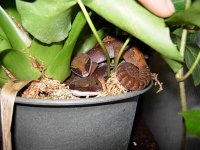gekkocorner
New member
I wanted to find out from other Aeluroscalabotes felinus keepers/breeders if any of you are keeping or have kept Cat geckos together either on MF ratio or FF?
I know that in the care sheets available and many posts here in this forum It is recommended to house them individually, and this will probably generate some debate but I want to know if any of you has had success or any negative effects from keeping them together?
Reason I ask is because before I had any knowledge of this website I kept a pair (gravid female pictured) that had been housed together for over three years, the female laid fertile eggs and they both had very fat tails and did wonderfully. This particular pair slept in different hiding spots, but at night they usually hanged out close to each other. I sold these pair recently to make space for others but I still have eggs incubating from them.
With the recent shipment of Borneos, I ran out of space to house them all and I decided to keep 4 females that were in good shape together in groups of 2 for a few weeks. So far I'm very impressed with the results. They are doing fantastic and even though they are housed in larger terrariums ( 18x18x24In ) with several places to hide, they sleep together night after night. I'm also attaching a picture of them sleeping together.
I understand that Aeluroscalabotes are said to be solitary animals in the wild but does anybody have any data of studies done to wild felinus to show if they were almost always found alone? or if they are territorial towards each other? etc.
Any input or comments will be apreciated
I know that in the care sheets available and many posts here in this forum It is recommended to house them individually, and this will probably generate some debate but I want to know if any of you has had success or any negative effects from keeping them together?
Reason I ask is because before I had any knowledge of this website I kept a pair (gravid female pictured) that had been housed together for over three years, the female laid fertile eggs and they both had very fat tails and did wonderfully. This particular pair slept in different hiding spots, but at night they usually hanged out close to each other. I sold these pair recently to make space for others but I still have eggs incubating from them.
With the recent shipment of Borneos, I ran out of space to house them all and I decided to keep 4 females that were in good shape together in groups of 2 for a few weeks. So far I'm very impressed with the results. They are doing fantastic and even though they are housed in larger terrariums ( 18x18x24In ) with several places to hide, they sleep together night after night. I'm also attaching a picture of them sleeping together.
I understand that Aeluroscalabotes are said to be solitary animals in the wild but does anybody have any data of studies done to wild felinus to show if they were almost always found alone? or if they are territorial towards each other? etc.
Any input or comments will be apreciated
Attachments
Last edited:







